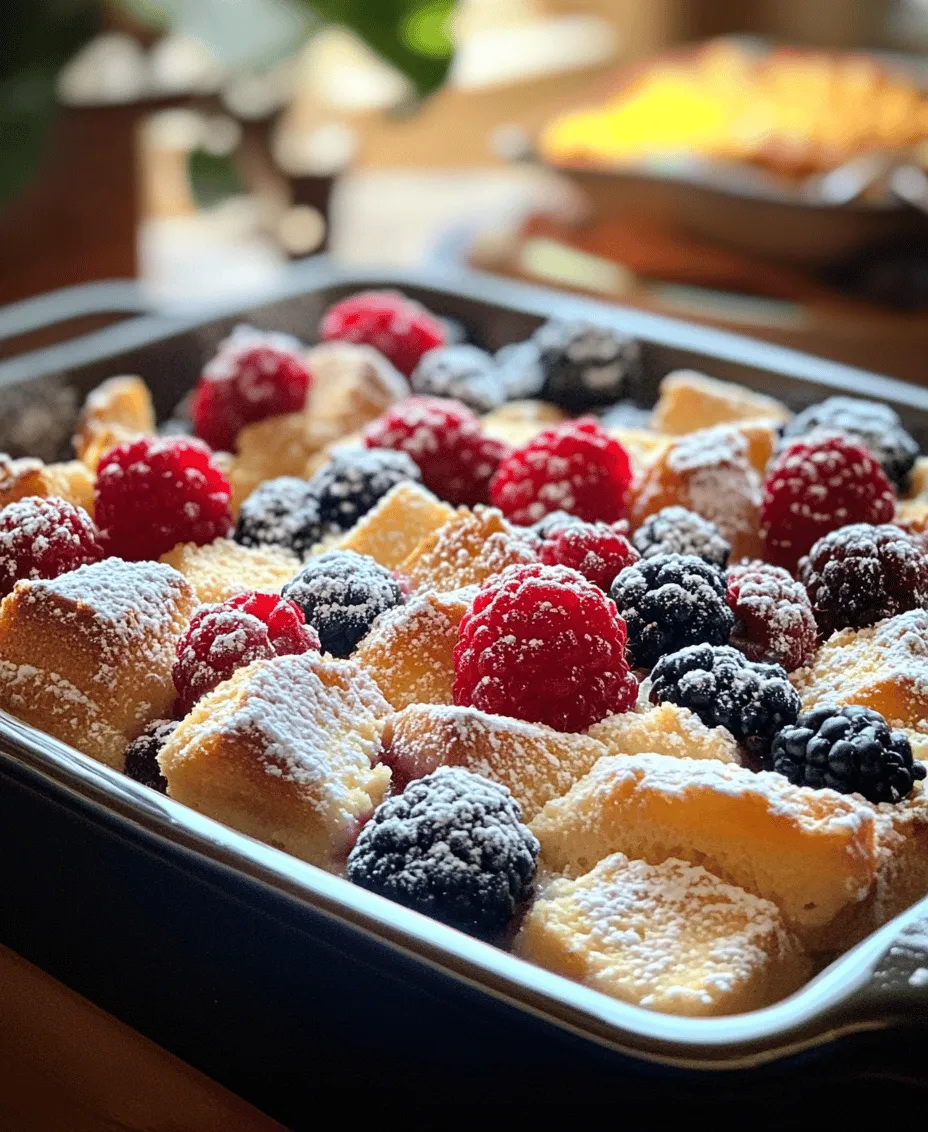Introduction
Breakfast is often touted as the most important meal of the day, a time to refuel and prepare for whatever lies ahead. Among the many options available, breakfast bread pudding stands out as a comforting and indulgent dish that combines the warmth of baked bread with the richness of custard. This delightful recipe not only satisfies your hunger but also evokes a sense of nostalgia and home-cooked love, making it a perfect choice for family gatherings or leisurely weekends.
One of the key secrets to achieving the perfect breakfast bread pudding lies in the use of day-old bread. Fresh bread may seem like the best choice, but using bread that is a day or two old enhances the texture and flavor of the dish significantly. Day-old bread has had time to dry out slightly, allowing it to soak up the custard mixture more effectively without becoming overly soggy. This results in a beautifully balanced pudding where each bite is a delightful combination of creamy custard and tender bread.
In this recipe, we will introduce you to the essential ingredients that come together to create this breakfast masterpiece. From the bread itself to the custard base and delightful toppings, each component plays a vital role in crafting a breakfast bread pudding that will have you and your loved ones coming back for seconds.
Understanding the Basics of Bread Pudding
Bread pudding is a classic dessert that has stood the test of time, with its roots tracing back to various cultures across the globe. Defined simply, bread pudding is a dish made from stale bread soaked in a mixture of milk, eggs, and sweeteners, then baked until set. What makes this dish particularly appealing is its versatility; it can be served warm or cold, as a breakfast item, dessert, or even a snack, depending on the ingredients and preparation method.
Historically, bread pudding emerged as a way to make use of leftover bread, minimizing waste and maximizing flavor. In many cultures, this dish has evolved into a beloved favorite, with regional variations reflecting local flavors and ingredients. For example, in France, you might find a version known as “pain perdu,” which translates to “lost bread,” while the British have their own take with “bread and butter pudding,” often layered with buttered slices of bread and a custard mixture. In the southern United States, bread pudding is often enriched with spices and served with a sweet sauce, showcasing the diversity and creativity behind this timeless recipe.
Given its comforting nature, bread pudding has become a popular choice for breakfast and brunch. The combination of warm, custard-soaked bread, often enhanced with spices and toppings, makes it an irresistible option for starting the day on a high note. Whether served plain, with fresh fruit, or drizzled with syrup, breakfast bread pudding offers a delightful way to enjoy a hearty meal that feels both special and satisfying.
Ingredient Breakdown
To craft the perfect breakfast bread pudding, it’s essential to select the right ingredients. Each element contributes uniquely to the overall flavor and texture of the dish. Here’s a detailed breakdown of the key ingredients you’ll need:
Day-Old Bread
The cornerstone of any bread pudding is, of course, the bread. When selecting the type of bread, consider using brioche or challah, both of which are rich in flavor and texture. Brioche is a soft and buttery bread that adds a luxurious quality, while challah, a traditional Jewish bread, offers a slightly sweeter and denser option. The goal is to use day-old bread that has lost some moisture, allowing it to soak up the custard without disintegrating. If you don’t have day-old bread, you can also lightly toast fresh bread in the oven to achieve the desired consistency.
Eggs
Eggs serve a dual purpose in this recipe. They act as a binding agent, helping to hold the bread together, and they contribute to the custard-like texture that is characteristic of a good bread pudding. When mixed with the dairy components, eggs create a creamy base that envelopes the bread, ensuring that each bite is rich and satisfying.
Dairy Components
Whole milk and heavy cream are the stars of the custard mixture. Whole milk brings a touch of creaminess, while heavy cream adds a luxurious richness that elevates the dish. The combination of these two dairy products ensures that the bread pudding is moist and flavorful. If you’re looking for a lighter version, you can substitute part of the heavy cream with additional whole milk or even a non-dairy alternative like almond milk, but be aware that this may alter the texture slightly.
Sweeteners
The balance of sweetness is key to a delicious breakfast bread pudding. A combination of granulated sugar and maple syrup works wonders, as the sugar enhances the overall sweetness while the maple syrup adds a distinct flavor profile. You can adjust the amount of sweetener based on your personal preference, but be careful not to overdo it, as the bread and toppings will also contribute to the overall sweetness of the dish.
Spices
Cinnamon and nutmeg are essential spices that elevate the flavor of the bread pudding. Cinnamon adds warmth and a comforting aroma, while nutmeg brings a subtle, nutty depth that complements the sweetness. Feel free to adjust the quantities based on your taste preferences, but a well-spiced bread pudding is sure to impress.
Berries and Nuts
Adding fresh or frozen berries and nuts not only enhances the flavor but also provides nutritional benefits. Berries such as blueberries, strawberries, or raspberries add a burst of freshness and acidity that balances the richness of the custard, while nuts like pecans or walnuts introduce a delightful crunch. If using frozen berries, there’s no need to thaw them before adding, as they will release their juices during baking, creating a beautiful and flavorful baked pudding.
Step-by-Step Preparation
Now that we’ve covered the foundational elements of our breakfast bread pudding, it’s time to dive into the preparation process. Following these steps will ensure that you create a dish that is both delicious and visually appealing.
Preheating the Oven
Before you start assembling your ingredients, it’s important to preheat your oven to 350°F (175°C). This ensures that the bread pudding bakes evenly and thoroughly, resulting in the perfect texture. An adequately heated oven helps to set the custard quickly, preventing the bread from becoming overly soggy.
Preparing the Bread
The first step in preparing your breakfast bread pudding is to cut the day-old bread into cubes. Aim for approximately 1-inch cubes to ensure even soaking and baking. If the bread is particularly dry, feel free to tear it into pieces rather than cutting it, as this can create a more rustic texture. Once cubed, place the bread in a large mixing bowl and set it aside.
Mixing the Custard
In a separate bowl, whisk together the eggs, whole milk, heavy cream, granulated sugar, maple syrup, and spices until smooth. This mixture should be well combined to ensure that the eggs are fully incorporated, which will help create a uniform custard. After mixing, pour the custard over the cubed bread, ensuring that every piece is coated in the liquid. Allow the mixture to sit for at least 15 minutes, giving the bread time to absorb the custard. This step is crucial, as it allows the bread to soak up the flavors and moisture, resulting in a tender and flavorful pudding.
Adding the Berries and Nuts
Once the bread has absorbed the custard, gently fold in your choice of berries and nuts. This not only adds texture but also infuses your bread pudding with fruity flavor and nutritional goodness. Be careful not to overmix, as you want to maintain the integrity of the bread pieces.
With these initial steps complete, you’re well on your way to creating a delicious breakfast bread pudding that is sure to become a family favorite. As we continue, we will explore further steps in the baking process, including tips for achieving the perfect consistency and presentation. Stay tuned for the next part, where we will guide you through baking and serving this delightful dish.

Crafting the Custard Mixture
To create a perfect breakfast bread pudding, the custard mixture is the heart of the dish. The right techniques can ensure a smooth blend that seamlessly integrates into your bread. Start by whisking together eggs, milk, cream, sugar, vanilla extract, and a pinch of salt in a large mixing bowl. It’s essential to use a whisk or an electric mixer on low speed to avoid over-whipping, which can incorporate too much air and create a fluffy texture that doesn’t work well for bread pudding.
When mixing, take your time. Ensure the eggs are fully beaten before adding the milk and cream; this will help achieve a uniform consistency. Once combined, let the mixture rest for a few minutes to allow the flavors to meld together. If you’re looking to enhance the custard further, consider adding a dash of nutmeg or cinnamon for warmth, or even a splash of orange liqueur for a sophisticated twist.
Combining Bread and Custard
Once your custard is ready, the next crucial step is combining it with your bread. The type of bread you choose can significantly influence the pudding’s texture and flavor. Stale or day-old bread works best, as it absorbs the custard more effectively without turning mushy. Cut the bread into cubes or tear it into pieces, depending on your preferred presentation.
Once the bread is prepared, place it in a large baking dish and pour the custard mixture over it. Gently press down on the bread pieces with a spatula or your hands to ensure thorough saturation. This step is vital—allow the mixture to sit for at least 30 minutes, or even overnight in the refrigerator. This resting period allows the bread to fully absorb the custard, resulting in a rich, creamy texture.
Incorporating Berries and Nuts
Adding berries and nuts to your breakfast bread pudding not only enhances the flavor but also adds a delightful texture. Fresh or frozen berries like blueberries, raspberries, or strawberries can be folded into the mixture before baking. To prevent them from sinking to the bottom, toss them in a bit of flour before mixing them in. This light coating helps them stay evenly distributed throughout the pudding.
When it comes to nuts, walnuts and pecans are excellent choices that add crunch and depth. Chop the nuts into bite-sized pieces and sprinkle them over the top of the pudding mixture before baking. This will ensure they toast nicely in the oven, providing a satisfying contrast to the soft custard and bread.
Greasing the Baking Dish
To prevent sticking and make for an easy cleanup, greasing the baking dish is essential. Use butter or cooking spray to coat the inside of the dish thoroughly. For an extra layer of flavor, consider using melted butter, which will not only prevent sticking but also impart a delightful buttery taste to the crust of the bread pudding. Ensure you cover all corners and edges, as these are the areas most prone to sticking.
The Role of Maple Syrup in Flavor Elevation Before Baking
Maple syrup is not just a topping—incorporating it into the custard mixture can elevate the overall flavor profile of your breakfast bread pudding. Add a few tablespoons of pure maple syrup to the custard before mixing it with the bread. This will infuse the pudding with a subtle sweetness that contrasts beautifully with the richness of the custard. If you prefer a less sweet option, you can drizzle the syrup on top right before serving, allowing each guest to customize their sweetness level.
Baking the Bread Pudding
Baking Time and Temperature
Preheat your oven to 350°F (175°C) for optimal baking. The baking time for your bread pudding will generally fall between 45 to 60 minutes. However, the exact duration can vary depending on your specific oven and the thickness of your pudding. Look for the edges to puff up and turn golden brown, while the center should be set but still slightly jiggly.
Variations in Baking Based on Oven Types
If you’re using a conventional oven, the heat distribution is typically even, allowing for consistent baking. If you have a convection oven, it might bake faster due to the circulating hot air. Therefore, keep an eye on your bread pudding and check for doneness a few minutes earlier than the suggested baking time.
Tips for Checking Doneness: The Knife Test Explained
To check if your bread pudding is perfectly baked, use the knife test. Insert a clean knife into the center of the pudding. If it comes out clean or with just a few moist crumbs attached, your bread pudding is done. If it’s still liquidy, allow it to bake for an additional 5-10 minutes, then recheck.
Serving Suggestions
Presentation Ideas for Serving Bread Pudding
When it comes to serving your breakfast bread pudding, presentation can elevate the experience. Consider cutting the bread pudding into squares and serving it warm on a plate. A light dusting of powdered sugar can add a touch of elegance. For a more rustic feel, serve it directly from the baking dish with a large spoon for family-style dining.
Pairing Options: Best Accompaniments
To enhance the flavors of the pudding, consider pairing it with whipped cream, crème fraîche, or a dollop of Greek yogurt. These creamy elements provide a wonderful contrast to the warmth of the bread pudding. Additionally, offering a side of fresh fruits or a berry compote can add brightness and balance the richness of the dish. For those who enjoy extra sweetness, a drizzle of maple syrup or honey can be delightful.
Seasonal Variations
One of the most appealing aspects of bread pudding is its adaptability to seasonal ingredients. In the summer, consider adding fresh peaches or cherries, while in the fall, apples and pears can be excellent options. During winter, dried fruits like apricots or figs can add a lovely chewiness and depth of flavor. By changing up the fruits and nuts, you can create a new version of this dish for every season.
Nutritional Information and Health Considerations
Breakdown of Calories and Nutrients Per Serving
A typical serving of breakfast bread pudding (about 1 cup) contains approximately 300-400 calories, depending on the specific ingredients used. This includes a balance of carbohydrates from the bread, protein from the eggs and dairy, and healthy fats from any nuts added.
Discussion of Potential Dietary Adaptations
For those looking to make dietary adaptations, there are several options. To create a gluten-free version, substitute regular bread with a gluten-free bread blend. For a dairy-free alternative, you can use almond milk or oat milk instead of regular milk and cream. Adjusting the sugar content can also cater to dietary needs, using natural sweeteners like agave or monk fruit sweetener.
Balance of Indulgence and Nutrition in Breakfast Choices
While breakfast bread pudding is undoubtedly a comforting indulgence, it can be balanced with nutritional considerations. By incorporating fruits and nuts, you add fiber, vitamins, and healthy fats, making it a more wholesome choice. Enjoying this dish in moderation can allow you to savor its delicious qualities without compromising your health goals.
Conclusion
Breakfast bread pudding is a delightful and versatile dish that combines the comforting elements of bread, custard, and an array of delicious add-ins. Its warm, creamy texture and sweet flavors make it an ideal choice for brunch gatherings or cozy family breakfasts. This recipe not only brings joy to your table but also provides an opportunity to experiment with flavors and ingredients, encouraging creativity in the kitchen.
Invite friends and family over to share in the love of this dish, as it is best enjoyed in good company. With its ability to adapt to various seasons and personal tastes, breakfast bread pudding is sure to become a cherished favorite in your home. So gather your ingredients, roll up your sleeves, and embark on a delightful culinary adventure that will surely impress. Enjoy the process and savor each bite!



